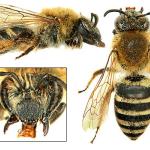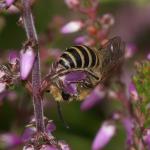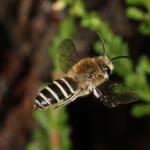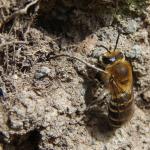Apis fuliginosa SCOPOLI 1770; Apis invictus HARRIS 1776; Apis glutinans CUVIER 1798; Apis calendarum PANZER 1806; Colletes balteatus NYLANDER 1852; Colletes kervillei PÉREZ 1908; Andrena xanthothorax EVERSMANN 1852
Widely distributed throughout Britain, occurring as far north as Sutherland, the Outer Hebrides (Barra and South Uist) and Orkney (Hoy). Known too from the Isles of Scilly, Lundy, the Isle of Man and the Channel Islands (Alderney, Guernsey and Jersey). Widespread in southern Ireland. This species is found throughout much of Europe and north Africa, and in Asia, from Iran to Tibet.
This species is not regarded as being scarce or threatened in Britain.
Mainly dry heaths and moorland. The species is also known from a number of coastal and other inland sites, both in Britain and Ireland, from which the main pollen sources (see below) are apparently absent. Unlike many bees, this species has been seen flying actively in dull, overcast conditions and even in a heavy shower (G R Else, pers. obs.).
Univoltine; from mid-July to late September.
In southern Britain this species generally seems to nest singly or in small aggregations. However, in northern England and Scotland, large, compact nesting aggregations are more frequently encountered. Some of these are huge. For example, in North Yorkshire, one containing 60-80,000 nests occurred along a 100 m length of river bank (see photograph in O 'Toole & Raw (1991)). Nest architecture has been illustrated by O'Toole (1986). Winter can be passed in any of the early stages (egg to pupa), though more usually as a prepupa in diapause (C. O’Toole, pers. comm.).
In common with females, males visit heather and heaths. The bee also flies to melilot (Melilotus sp.), yarrow (Achillea millefolia) (S Roberts, pers. obs.) and creeping thistle (Cirsium arvense).
The anthophorine bee Epeolus cruciger is a well-known cleptoparasite of C. succinctus in southern Britain. The bee-fly Bombylius minor has been seen to oviposit in burrows (Payne, 1974; M. Edwards, pers. comm.), and adults have been reared from cells of C. succinctus (I R Hudson, pers. comm.). M Edwards (pers. comm.) has also seen B. minor emerging from some burrows.
Profile written: 2001
Updated: December 2011





